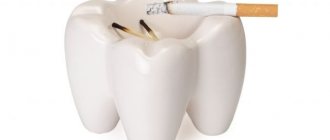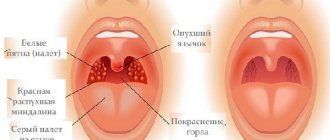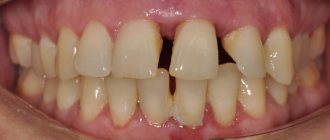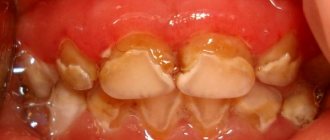One can understand the confusion of a person who discovers holes in his tonsils. In fact, there is indeed cause for alarm - this symptom indicates a serious pathological process in the oral cavity. And if adults have hope of doing without a protective barrier, the role of which is played by the tonsils, then in children, whose body and immunity are not yet fully strengthened, this disease poses a threat to health.
To prevent holes in the tonsils (tonsils) from causing complications, you need to promptly pay attention to alarming symptoms, identify the cause of their formation and receive qualified medical care.
Holes in the tonsils: what are they?
Normally, in a healthy person, the tonsils are structured like a porous sponge and contain approximately 20 depressions (lacunae), which are designed to contain pathogens. During illness, this first line defense mechanism prevents the infection from progressing further.
Microbes settle in the gaps - clots of white or yellow pus become noticeable on the tonsils; by the way, these are the only tonsils in the body that you can see for yourself.
This organ has the ability to recover on its own and after treatment, the tonsils take on their previous appearance, becoming whole, dense, covered with pale pink mucous.
Holes in the tonsils: photo
In the case of frequent illnesses, complications, or reduced immunity, this process is disrupted and the lacunae are closed with degenerated lymphatic tissue, which visually looks like holes in the palatine tonsils. These holes become collections for food debris, bacteria, and dead epithelial cells, which form purulent plugs.
When asked what kind of holes are in the tonsils, the doctor diagnoses the patient with chronic tonsillitis.
Severe tonsillitis tonsillitis
The most serious pathology caused by the active reproduction of streptococcus or the penetration of viruses of various natures is considered to be sore throat. It is very important to diagnose in time to prevent the development of serious complications.
As a result of normal hypothermia, a person’s immunity weakens, and bacteria and viruses begin to actively colonize new territories. With an advanced cold, tonsillitis develops, the signs of which are:
- Weakness, headache, fever. Body temperature rises to 39 C.
- Sensation of a foreign body in the throat, difficulty swallowing saliva and eating.
- Change in color of the tonsils to red, increase in their size, loosening, whitish coating.
- In places where there were pits, nodules filled with pus can be seen on the tonsils, which are opened as a result of regular rinsing.
- The lymph nodes in the neck enlarge, which the specialist feels upon palpation.
Tonsillitis is not only a consequence of the inflammatory process if there are holes in the tonsils, but in itself actively contributes to the formation of new depressions. It is very important to treat sore throat thoroughly and promptly in order to prevent pathologies such as damage to the heart, kidneys, joint and bone tissues.
What are the symptoms?
In addition to visual identification, holes in the tonsils are accompanied by other symptoms that should alert you. These include:
- swelling of the palatine tonsils;
- sensation of a foreign body in the throat;
- discomfort when swallowing, inability to perform a full act of swallowing;
- expectoration of white lumps (caseous plugs);
- foul breath that cannot be masked by anything;
- elevated body temperature (sometimes).
Together, these symptoms indicate the development of an inflammatory process in the throat.
Causes of holes in the tonsils
Several conditions can affect the tonsil openings and increase the risk of infection, including:
Tonsillitis
Tonsillitis occurs when the tonsils become inflamed due to a viral or bacterial infection. A person with tonsillitis may have enlarged lymph nodes in the neck. Other symptoms of tonsillitis include:
- a sore throat;
- pain when swallowing;
- headache;
- fever;
- nausea;
- vomiting
Angina
Sore throat is a form of tonsillitis. This infection of the throat and tonsils is more common in children. A sore throat occurs when there is contact with group A Streptococcus bacteria, which enter the body through coughing and sneezing. Symptoms of streptococcal sore throat:
- sore throat;
- pain when swallowing;
- enlarged tonsils, which may be red with streaks of pus;
- enlarged lymph nodes in the neck;
- red spots on the roof of the mouth;
- fever.
Mononucleosis
Mononucleosis
is another condition that can cause inflammation of the tonsil openings. Symptoms include:
- a sore throat;
- enlarged tonsils with pus;
- weakness;
- fever;
- rashes;
- headache;
- pain throughout the body;
- enlarged lymph nodes in the neck and armpits;
- less often, enlargement of the liver or spleen.
Mononucleosis is most common among teenagers.
Infectious mononucleosis is caused by the Epstein-Barr virus. Symptoms may last 4 to 6 weeks.
Poor oral hygiene
Poor oral hygiene can affect the tonsil holes. If a person does not practice oral hygiene, the buildup of bacteria can cause an infection in the tonsils.
Symptoms of poor oral hygiene include:
- bad breath;
- plaque on teeth;
- coated tongue;
- tonsil stones.
Tonsil stone
A tonsil stone can occur when food, dead cells or bacteria get into the openings in the tonsils and calcify, forming hard stones. People with chronic inflammation of the tonsils may be more likely to develop tonsil stones. Sometimes tonsil stones can grow, making the tonsil holes larger and increasing the infection. Symptoms of tonsil stones:
- a sore throat;
- bad breath;
- a white coating visible on the back of the throat;
- problems with swallowing;
- ear pain;
- constant cough.
For many people, tonsil stones do not cause any symptoms and may not be treated.
Cancer of the tonsil and oral cavity
In rare cases, people associate tonsil holes with oral cancer that affects a person's tonsils.
Signs and symptoms of oral cancer include:
- sores that appear in the back of the mouth and do not heal;
- one tonsil is larger than the other;
- a sore throat;
- ear pain;
- pain when swallowing;
- swelling in the neck;
- blood in saliva;
- bad breath.
Causes of holes in tonsils
Holes in the tonsils cannot just happen. Their appearance means an active increase in lymphocytes (the body's defenders), in tissue cells that begin to divide and grow.
As a result, the tonsils acquire a loose, deformed structure. The reasons why holes remain after traffic jams include:
- bacterial infections. Due to the proliferation of microbes, the lymphatic tissue of the tonsils becomes swollen, which leads to the expansion of natural lacunae;
- rehabilitation period after illness. The tonsils need some time to recover in size after suffering a viral disease;
- frequent hypothermia;
- enlarged nasopharyngeal tonsils (adenoids). This pathology is accompanied by a chronic inflammatory process;
- inflammation of the maxillary sinuses, which is characterized by the accumulation of large amounts of pus;
- dental diseases;
- dental infections of the oral cavity – stomatitis, inflammation of the tongue, gingivitis;
- congenital or acquired deformation of the nasal septum.
When the throat hurts very badly and holes in the tonsils, which are filled with pus, appear as a result of lacunar tonsillitis.
All these factors significantly reduce the body’s defenses, as a result of which the tonsils, being the center of attack of pathogenic bacteria, become deformed.
Do I need to see a doctor?
If, with the help of a mirror, a hole was discovered in the tonsil, and there is pus inside, this is a serious reason to consult a doctor, since in this way only a small part of the inflammatory process can be seen.
Moreover, it is categorically impossible to remove these accumulations of pus on your own - even the slightest damage to the lymphoid tissue can provoke the spread of infection throughout the body, including blood poisoning.
Cases where there are holes in the tonsils, but they are without pus, should not be ignored by doctors either. The presence of such a deformation indicates the absence of a natural barrier to infections and is a favorable environment for the free proliferation of pathogenic microbes.
First, you can seek help from a general practitioner, who, if necessary, will refer the patient to specialized specialists - an otolaryngologist or an ENT surgeon.
Methods for diagnosing pathology
At the appointment, the doctor examines the tonsils using a laryngeal mirror, a magnifying glass and a light source, collects anamnesis, and states the general condition.
Additionally, he examines the nasal cavity and auditory canals. To make a diagnosis and identify concomitant diseases, the doctor gives directions for laboratory and diagnostic tests:
- General and biochemical blood test. Indicators of the levels of red blood cells, leukocytes and platelets will help determine the presence of an inflammatory process or any neoplasms;
- general urine analysis. Necessary for detecting pathological processes in the body that reduce immunity and worsen the patient’s condition;
- smear for bacterial culture. Epithelial cells of the pharynx will help determine the type of pathogenic organisms, which will help in choosing the right therapeutic tactics.
Bacterial studies are carried out with a button probe, which is inserted to determine the presence of adhesions characteristic of chronic tonsillitis.
If a malignant neoplasm is suspected, a biopsy of the lymphoid tissue of the throat is performed.
Treatment methods
You can get rid of holes in the tonsils filled with pus only by eliminating the true cause of the inflammatory process. Self-medication in such cases is contraindicated, since only an experienced doctor will be able to provide complex therapy, minimizing serious complications.
Taking antibiotics
When pus accumulates in the lacunae, broad-spectrum antibacterial drugs are used, which not only inhibit the proliferation of bacteria, but also completely destroy them. Depending on the type of pathogenic pathogens, drugs such as Azithromycin, Tsiprolet, Amoxicillin are prescribed.
Washing tonsils in the ENT office
To clean them of purulent plugs, a syringe with a special attachment is used, which directs the disinfectant composition directly into the lacunae. A jet under pressure knocks out the plugs, and the tonsils are cleared. For full results, at least 15 sessions are required.
Vacuum lavage of the tonsils is carried out under local anesthesia using a device. A special nozzle is attached to the tonsil, and the purulent contents are sucked out through it. The tonsils are then treated with an antiseptic to prevent relapse.
Another device, Tonsilor, is actively used by doctors to treat purulent tonsils. The impact on the tonsils is carried out using ultrasound and vibrations transmitted by a special attachment. When the purulent plug becomes pliable, it is washed out with a medicinal solution, which is delivered in a strong stream.
Physiotherapy
The most popular and effective procedures are using:
- ultraviolet rays, which have a powerful antibacterial effect;
- laser, which activates blood and lymph flow in the tonsils, relieves inflammation;
- ultrasound, with the help of which medications penetrate deep into the tissue of the tonsils.
Also, throughout the entire treatment, the doctor prescribes rinsing the mouth and throat with antiseptic solutions (Furacilin, Miramistin), taking immunostimulating drugs, and vitamin complexes.
How to treat at home?
Trying to remove purulent plugs at home is not worth it because of the huge risk of complications. However, for disinfection and strengthening local immunity, traditional medicine recipes can be useful. Suitable for rinsing:
- decoction of onion peels. It must be washed, poured with a small amount of water, brought to a boil and simmered over low heat for 5-7 minutes. Then let the broth brew for at least 3 hours. Use warm;
- beet juice. The root vegetable, crushed in a blender, is sprinkled with table vinegar and left on the table for several hours. Then the juice is squeezed out of the grounds and gargled with it;
- herbal infusion. Pour dry raw materials of chamomile, calendula and plantain into a thermos, pour boiling water over everything and leave to steep for several hours. Gargle after every meal;
- soda-salt solution. Dissolve a teaspoon of salt and soda in a glass of water, mix and use several times a day. The solution has a powerful antiseptic effect.
Rinsing should be done with your head thrown back so that the medicinal composition affects the tonsils as far as possible. The duration of each rinse should be at least 20 seconds.
Do they grow on their own?
If after a sore throat there are holes in the tonsils, the likelihood that they will completely heal is minimal, these holes will remain forever. You must be prepared for the fact that a caseous plug will form again at the mouth of the lacuna, do not start this process, and undergo treatment on time.
How to treat holes in tonsils
A competent otolaryngologist knows what to do if a problem occurs such as holes in the throat on the tonsils. After finding out the whole picture of the disease, he decides which treatment option to choose: medication or surgery.
Initially, tonsil holes are treated with conservative methods. If medications do not give the desired result, the patient has to agree to surgery, namely removal of the affected organ.
Removal of tonsils is recommended for patients who suffer from tonsillitis more than 5 times a year.
Use of folk remedies
You can’t use it right away, the juice needs to sit for a while.
Holes in the tonsils can be cured using folk remedies. But this point must be discussed with the attending physician.
Need to know! Folk remedies are effective for holes in the tonsils only if the pathology is mild and is not accompanied by an acute form of the disease.
To achieve the best result, it is recommended to combine traditional medicine methods with traditional topical preparations.
For holes in the tonsils, the following folk remedies are useful:
- Saline solution. To prepare the medicinal liquid, you need to dissolve 1 tsp in 1 glass of drinking water. salt and soda. In this case, it must be heated to 40 degrees. The entire contents of the glass must be thoroughly mixed. If desired, you can add 3 drops of iodine to the composition. The resulting solution should be gargled several times a day after meals. You are prohibited from eating or drinking anything for an hour after completing the procedure.
- Onion broth. You need to cook 2 tsp. onion peels in 1.5 liters of water. Afterwards, the product must be infused for 2 hours. This decoction is used for rinsing to wash away germs from the tonsils.
- Chamomile decoction. It is necessary to pour a glass of boiling water into 1 tbsp. l. dried chamomile flowers. The product must be infused for 30 minutes. Afterwards they gargle thoroughly.
- Beetroot juice. It must be prepared using a grater or blender. Afterwards you need to add 1 tsp to the mass. vinegar. The product is kept for the next 2 hours. Afterwards it is suitable for rinsing the tonsils and the entire throat.
If after using a folk remedy the situation worsens, then such therapy will have to be abandoned.
Antibiotic therapy
A course of antibiotic therapy can eliminate holes in the tonsils and prevent their further appearance. It must be agreed upon with the attending physician. It is the specialist who selects the appropriate drug for the patient and its optimal dosage.
Important! It is strictly forbidden to take antibiotics before consulting a doctor, as this may lead to new health problems.
If some time after starting antibiotics, the specialist does not observe improvements, he must make adjustments to the course of therapy to increase its effectiveness.
Other therapies
Antibiotics are not the only drugs that help with holes in the tonsils. You can learn how to treat the pathology at an appointment with an otolaryngologist. He will prescribe a course of medications that provide a comprehensive fight against the disease.
Holes in the tonsils are treated by regular gargling and irrigation. In the first case, various solutions are used that disinfect and help remove purulent masses. Sprays with an antiviral effect are used for irrigation.
As an auxiliary therapy, multivitamin preparations are prescribed, which help strengthen weakened immunity. Due to this, the body regains its strength to fight the pathological process within itself.
The entire medical course of treatment is selected by a specialist. He must take into account the indications for therapy and the compatibility of different drugs that will need to be taken in combination with each other.
What can be dangerous: possible complications
If tonsils with holes are ignored, the consequences can be very serious and even life-threatening. It's all about the high risk of infection getting from purulent lacunae into the blood. This can cause the following complications:
- cystitis;
- inflammatory process in the kidneys;
- persistent sore throat;
- toothache;
- pathological processes in the nasopharynx;
- inflammation of the respiratory tract;
- problems with the gastrointestinal tract;
- meningitis.
Purulent tonsils, as a constant source of infection, are very dangerous due to their close connection with the digestive, respiratory and circulatory systems.
Untimely and incorrect treatment can lead to an increase in the number of holes in the tonsils and an increase in the inflammatory process.
Preventive measures
You should maintain oral hygiene and not be lazy to visit the dentist
In order not to think about what to do if there are holes in the tonsils, you need to take care in advance of prevention to prevent their formation. We are talking about implementing the following rules and recommendations:
- It is necessary to regularly care for your oral cavity. Every morning and evening you need to brush your teeth and rinse your gums.
- It is advisable to review your daily routine and allocate enough time for sleep and rest.
- You need to give up bad habits.
- You should strengthen your immune system.
- It is necessary to avoid severe hypothermia of the body.
Holes in the tonsil area in most cases occur due to a weakened immune system and the development of inflammatory processes in the body. These same reasons lead to other serious health problems.
If holes are found in the tonsils, you must make an appointment with an otolaryngologist. It is best not to delay a visit to a specialist in order to avoid worsening the situation and developing complications due to other diseases. First of all, the doctor should become familiar with the cause of his patient’s anxiety and offer him to undergo a full diagnosis. As soon as he studies the picture of the disease, he will be able to select the optimal course of therapy for the patient. This is the only way to deal with tonsil holes and prevent the recurrence of holes in the organ after some time.
When is surgery needed? Surgical removal
Removal surgery is needed only if their tissues are irreversibly atrophied, and constant sore throats seriously undermine the body. The surgical procedure is performed under local anesthesia or general anesthesia and gets rid of caseous plugs forever. Rehabilitation takes place in a hospital under the supervision of a doctor and takes up to 6 days.
Another method of removing tonsils is cryodestruction. When exposed to low temperatures with the help of liquid nitrogen, the tonsils are completely destroyed. The procedure is performed under local anesthesia and takes only a few minutes. Hospitalization after manipulation is not required.
Prevention
To avoid serious health problems, it is important to follow preventive measures, which include:
- Oral hygiene – regular brushing of teeth, use of medical or home remedies for rinsing after each meal;
- quitting smoking, as the toxic substances of tobacco smoke have a negative effect on the mucous membranes;
- compliance with the temperature regime - hypothermia should not be allowed.
Proper nutrition and an active healthy lifestyle will strengthen the body and enhance its protective reactions.
If you pay attention to the disease in a timely manner, the treatment will be easy and painless. In contrast to advanced cases, when the body has already been subjected to an infectious attack.
Holes of the palatine tonsils - treatment
Although your doctor will not treat tonsil holes, it may be necessary to address the underlying cause of any symptoms. Treatment will depend on the underlying problem.
A person with tonsillitis does not necessarily need treatment, as the body can fight the infection on its own. Your doctor may recommend drinking plenty of fluids, keeping you quiet, and taking pain relievers. If symptoms persist for 3-4 days or become severe, the person should see a doctor. Your doctor can test for streptococcus and prescribe antibiotics or other medications if needed.
If a person suspects that they have a sore throat caused by a streptococcal infection, they should consult a doctor. Your doctor will examine your throat and take a swab to check for the presence of group A streptococcus bacteria. A sore throat may require treatment with antibiotics. Antibiotics help reduce symptoms and prevent the infection from spreading. Treatment for mononucleosis may depend on its severity.
A person with mononucleosis should:
- drink plenty of water and other liquids;
- take medications to reduce high fever.
Doctors do not recommend treating mononucleosis with antibiotics such as ampicillin or amoxicillin.
If the spleen is enlarged, intense physical activity should be avoided, which can cause the spleen to rupture.
You should maintain oral hygiene:
- brush your teeth for 2 minutes at least twice a day;
- to drink a lot of water;
- use an antibacterial mouthwash;
- quit smoking.
Treatment for tonsil stones will depend on how large the stones are and whether they cause any symptoms.
Small stones can often be removed by rinsing with salt water. If this doesn't help, your doctor may use lasers or sound waves to remove the stones. Your doctor may also suggest a simple surgical procedure if the stones are large and difficult to remove.
Antibiotics are sometimes used to treat tonsil stones and their side effects, especially if they cause an infection.
Treatment for oral and tonsil cancer will depend on the type of cancer, its stage, and how far it has spread. Treatment may include surgery, chemotherapy, or radiation therapy.











